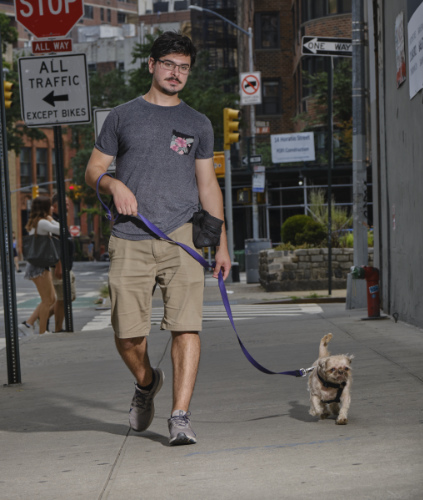Walking Your Dog NYC
Set You and Your Dog up for Success
Some people like to take their dogs absolutely everywhere with them. Who doesn’t want their furry friend by their side at all times? However, this often means that the walk is about wherever the human wants to go, and not necessarily what the dog wants. Maybe the dog doesn’t want to go into that crowded post office. Maybe the dog wants to go slowly and cautiously past the giant growling dog on the corner instead of being dragged quickly past so the owner can rush to their coffee date. The dog gets stressed and won’t walk, owner gets frustrated, and it just creates a nasty feedback loop of impatience and stress.
Set up your walks so that the walk is about what the dog wants to do! If she wants to walk slowly, walk slowly. If she wants to turn around, turn around. If she wants to avoid a dark scaffold, go around it. If she wants to sit and wag her tail, let her sit and wag her tail. If she wants to keep walking instead of saying hi to the cute puppy, let her keep walking. Asking your dog what they would like to do is paramount! This ensures that they have a choice. You are the ultimate arbiter of that choice, though, and you also need to protect them from choosing bad choices. Boundaries still exist!
This may mean that you need to not take her everywhere with you for a while, but we promise you will see a lot more progress if she is allowed to have some freedom of choice!
You might also be interested in great places to walk your dog in chelsea.
Pay Attention and Cut Down Distraction
This one is simple, and in line with Tip #2. Listen to your dog. Pay attention to her and what she is telling you. Keep a lookout for any triggers coming down the block.
Your smartphone can wait a few more minutes. It’s your dog’s time, focus on her and listen to what she is telling you!
Picture this: somebody is riding their bike down 5th Avenue. They’re texting on their phone. Not not safest situation, right? They’re also listening to music through their headphones. Even less safe, now they cant hear whats going on around them as well. Oh, and finally, they also have their dog, on leash, running next to them on the street.
This may seem ridiculous, but we can assure you, it’s more common than you think. I once saw somebody riding a bike on a busy avenue with six dogs leashed and running alongside them.
We don’t even like when people text and drive a car, let alone doing all of these other things and putting and animal’s safety on the line. Look around when you see people with dogs and you’ll start to notice just how distracted they are, and how many unsafe situations crop up because of it.
Practice having it just be you, your dog, and some treats!
Think About Trigger Stacking
What is trigger stacking? Trigger stacking is a cumulative buildup of stress. When a dog is exposed to stressful triggers, each one adds more stress than the last. They may be able to handle a few triggers without having an outburst. But there may come a point when they have been triggered so many times that they can’t contain their stress anymore and they lash out!
This can happen with people too. However, dogs can’t use words to tell us that they are stressed out, so if you’re not paying attention, it can be very easy to miss. If a trigger appears and your dog moves past it seemingly without reacting, that doesn’t mean that they aren’t feeling the stress! For now, they are able to handle it. But what about if ten more triggers come along?
Practice avoiding triggers in the first place. If you have seen a few triggers already, think about heading back home if your dog’s body language is telling you she might be a bit stressed out. Signs of trigger stacking may include stiffening of the body, harder bites when taking treats from you, hypervigilance (looking around for signs of danger), and of course, full on barking and lunging outbursts if they have passed the stacking threshold.
Help Your Dog When She’s Having Trouble
So here we can talk about specific ways to actually help your dog when she is having trouble outside. This requires you to be focused and take an active roll in actively mitigating potential situations.
One way you can help is by avoiding triggers, like we already mentioned. But what do we mean by that specifically? That means if you see a trigger approaching, it’s time to turn around, run away, hide, or move out of sight. Get out of there! Seeing a trigger can cause your stress to spike, the leash to get tight, and thus your dog’s stress can spike even before they see the trigger. While sometimes you have no choice but to pull a dog away from an unexpected problem, you can practice seeing triggers way in advance, staying calm, and keeping things relaxed while you skillfully avoid problems.
Another way you can help is with food. If your dog is a chow hound, keep some delicious treats on you when you go for walks. If she sees a trigger in the distance but she’s still calm, give her treats! If you need to walk by something a little scary, treats! If you need a distraction, treats! Treats are not a magical solution, but they can help distract from potential issues and associate something positive with triggers.
Give Your Dog Something To Do
This is a bit of “advanced” help. Sometimes when dogs are under stimulated outside, especially if they have a nervous temperament, they can become hypervigilant, looking for things to worry about. They have nothing else to do, and when they do see something scary, it’s all they can focus on.
Sometimes dogs feel safer if they are carrying a favorite toy, a bone, or a ball. It can almost act as a security blanket and it gives them something to do! This may take a bit of practice so they don’t drop it constantly, but if your dog loves carrying things around, this could be a fun one to try.
You can also teach your dog a bunch of tricks and bust these out during your walks! Walks turn from boring to exciting! You are giving them something to do, building their focus and bond with you, and generally helping them to be happy! Even just practicing a solid heel gives them something to work with.
Learn more about trick training [here] (link to our trick training page, my CTDI experience, etc…)
Breathe and Find the Stress
The most important (and also easiest!) tip we have if you are feeling stressed out on a walk is to BREATHE! Take some deep breaths. Stress manifests physically in the body. Feel where you are tense and focus on loosening those spots up. People tend to tighten the leash when they are stressed. Loosen up on the leash if you are doing this. Dogs get more stressed out if their leashes are being yanked on!
Here, we are going to briefly talk about acute vs. long term stress and how it affects your dog. Dogs interact with each other primarily through body language. Therefore, they are amazing at reading the body language of not just dogs, but humans too! When something stressful happens on a walk and you tense up, even if it’s just a little bit, your dog will notice and also tense up. If you also tighten up on the leash as part of your own body’s reaction to stress, this only adds to what your dog is mirroring. This is acute stress, stress that spikes quickly in a stressful situation.
Since dogs are looking to us and reading us, if we are stressed all the time, they will be too. This is long term stress. Stress levels in our dogs show a correlation with our stress levels over time. Check out our [Stress Levels] blog post to learn more!

